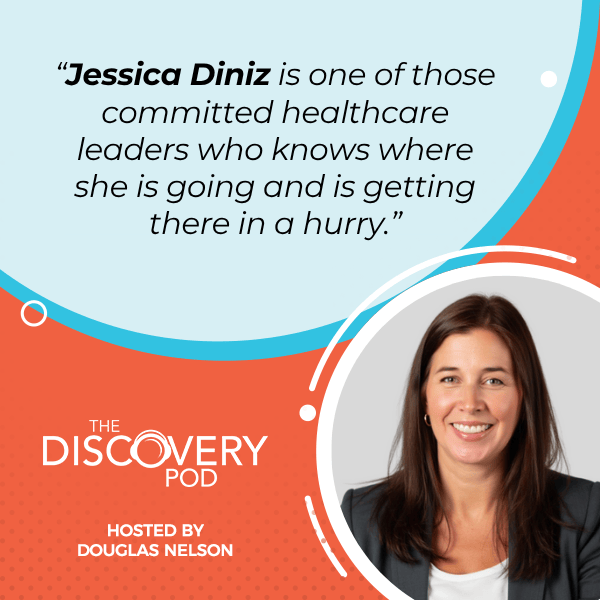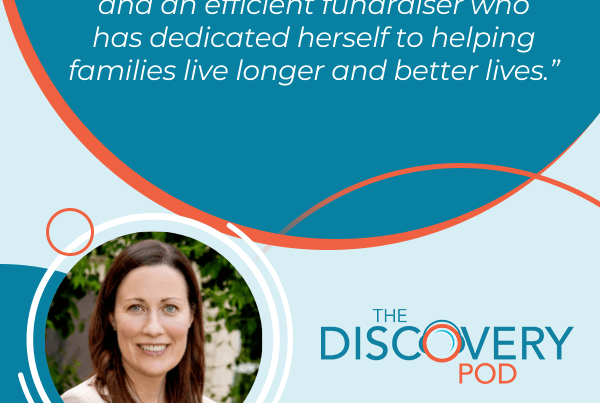
Type 1 diabetes is an autoimmune disorder which is growing quicker in Canada than many other countries and Jessica Diniz leads the charge in unlocking brand-new health breakthroughs to accelerate the pace of its research. She joins Douglas Nelson to share her experiences and insights as the president and CEO of Breakthrough T1D, one of Canada’s top national health charities dedicated to treating Type 1 Diabetes. Jessica talks about what it takes to lead a distributed team of a global organization and how to maintain a strong community of donors. She also discusses how COVID-19 vastly changed their revenue sources and how she guides her team in staying open to constant change.
—
Listen to the podcast here
Mission Beyond Boundaries With Jessica Diniz, President & CEO, Breakthrough T1D
We’re joined by Jessica Diniz, President and CEO of Breakthrough T1D Canada. Jessica joined the organization, formerly known as JDRF, in 2015 and now leads one of Canada’s top national health charities with a bold strategy to accelerate the pace of Type 1 diabetes research. With more than twenty years of experience in healthcare and research fundraising, including senior roles at Sunnybrook Foundation and Cystic Fibrosis Canada, Jessica brings energy, tenacity, and a gift for storytelling to her leadership.
In this episode, she shares the journey of renaming the organization and how she and her team are growing the organization and its community of donors across the country, and how she sees being a distributed team as an organizational superpower. Jessica is one of those leaders who knows where she’s going and is getting there in a hurry. There is a lot to learn from all that she shares in this episode. Please enjoy.
—
Welcome to The Discovery Pod, Jessica.
I’m glad to be here. It’s so great to have you here.
Jessica Diniz Of Breakthrough T1D
I’m really looking forward to the conversation. Many in our sector have looked at your organization and the big transformations that you’ve been through in terms of leadership, in terms of orientation, in terms of name over the last couple of years. We’ll get through all of that. I’m really interested in the implications of all that change and what you’re looking forward to. As we get started, tell us a little bit about the work that Breakthrough T1D Canada does and how your colleagues spend their time.
First and foremost, thank you so much for having me on this show. Breakthrough T1D, formerly named JDRF. That may be the name you’re more familiar with. We were founded in 1974. Existed for 50 years under that name. Who we are really, I just want to tell a little bit of a story because it really goes back to who we are. We were founded by two moms, and hats off to all the moms, being one myself, two moms who were incredibly frustrated. They were frustrated. They felt like no one understood Type 1 diabetes, and people were comparing it to Type 2.
Not enough was being done for two women in the US, and they started something. What I love is that this is a story of people stepping forward and saying, “I want to do something different.” They started, they mobilized, and this was in the US, where I think they raised $10,000 in the first year. This started to catch on as a movement, and some Canadian families heard about it and brought it to Canada.
Fast forward 50 years, and we exist in Australia, the UK, Israel, Denmark, Canada, and the US, but we fund the best Type 1 diabetes research around the globe. We fund 22 countries, and what we exist to do is envision a world without Type 1 diabetes. That is really the core of what we want. We want to cure this disease, but we also want to make people’s lives healthier along the way. We search for the best research around the globe.
We peer review it to make sure it is the highest quality of research. They win global competitions. We fund it. We accelerate their work, but I think the real difference maker is that we bring these researchers that we’re funding around the globe together, because that is the secret sauce. You cannot fund people individually and think that things are going to happen. We bring together, we call them consortia, on topics twice a year.
We make them share their learnings and what’s working, what’s not, because we don’t really care where the cure happens. We need to move the field of research forward. I think that’s a real difference maker. I’m asked a lot about that. That’s the difference maker to make change happen. You need everyone moving the work forward. If I can just for a second, because I think this was important, what Type 1 diabetes is.
Often, people don’t understand. It’s an autoimmune disorder. That means no lifestyle, no diet. You didn’t do anything to get it. There was no lifestyle change that could have happened. Your immune system attacks your body. This can happen at any time. I think this is so important because it goes back to why we changed our name. It used to be thought of as a kid’s disease.
Diabetes is an autoimmune disorder. No lifestyle or diet change brought it to you. It can attack your immune system anytime. Share on XIt only affects kids. Now, here’s an interesting stat for you, 88% of Canadians who live with Type 1 are over 19. We’re seeing more and more adults being diagnosed in their 40s, 50s, and 60s. We knew we needed to change. The word JDRF stood for Juvenile Diabetes. It’s not a medical term anymore. It’s Type 1 diabetes.
This idea actually fueled our desire and need to change our name. We knew we needed to represent our entire community and then to see themselves in our name and our brand. We also, with the name JDRF, people often asked us what we did, what we stood for. It was not clear. We said, “Let’s put our mission right up in the center so everyone knows we’re here to achieve breakthroughs.” We did a little bit there.
I really appreciate that. One of the things that we’ve worked with a number of organizations that have been contemplating a name change. Typically, the advice is, and I’m sure you heard it too, “Don’t do these things. Don’t change your name. Why would you do that?” Having worked with a number of organizations that did go through and change their name for very good reasons, and a very good reason you just described.
I’m curious. You go through the process, there’s excitement, and you can hear the excitement in how you’re telling that story. The board decides you have to reveal what it’s going to look like. You send it out into the world, and then the next Wednesday you’re back in the office. What’s different? There can be such internal momentum, you can feel like such a major crescendo, but then you still have to do the same work you had to do the week before you changed your name. How did that feel? How did that transition go for you and the team?
Those are great points. What I would say, my advice to anyone, if you are contemplating a name change, is that the process is almost just as important as the end result. We went through a six-month process, and because we’re a global organization, we brought in a global marketing agency to go through this process, because we needed to make sure it would be relevant in the US and the UK.
People use different terms to talk about Type 1 diabetes. The journey was just as important. We did a lot of stakeholder conversations along the way. I said, “That is critical if you’re contemplating a brand and name change so that you can make sure, and then testing to make sure it resonates with what you want it to resonate.” That was the learning. Make sure you’re engaging stakeholders along the way, that you have a defined process, and that you can explain very clearly why.
That’s what I would say, “Did everyone love our name?’ No. I’d say most of the community did and were thrilled to be recognized, but those who didn’t recognize the why agreed with the why. They agreed that we understand, no one calls it juvenile diabetes anymore. We appreciate that you’re changing your name to represent the entire community. Really think about the why. The why you’re contemplating the change.
That is really good advice. One of the things that I’ve seen is organizations thinking that the strategy is the name change, but really the name change is a part of, and not even a significant part of, a larger strategy when those name changes are successful and propel the organization forward. What was the bigger story that you wanted to tell with this name change? Being a global organization, recognizing both the name of the disease and the manner of research has changed so much. Share a little bit about what that larger strategy was.
It goes back to wanting to make sure our mission was right up front and center. We had a lot of feedback that people really didn’t understand. What do we exist to do? We wanted to put the word breakthrough. We think it’s the perfect word because it can encompass many things. We drive breakthroughs in scientific research, but what is a breakthrough?
Could a breakthrough also be a major policy change that ensures Canadians have access to many more devices that can save their lives? I’d say that’s a breakthrough. We thought the name helps illustrate really who we are and the culture that we want to have. To your question about what happens after you change your name, it’s been about a year since we changed our name.
I am living in a time where there is that work that goes up, all the logo changes, and the website, and that tactical work that has to happen. It’s how do you bring that brand to life? The new name and everything you do, and your volunteers. What we speak about a lot is that our volunteers and staff are ambassadors for that brand. They can help really get out there and explain who you are and what you do for their work.
Bringing Donors, Researchers, And Communities Together
One of the things that’s always fascinated me about the organization, and I’ve been really impressed with how the organization has handled it. Anyone who’s spent any time in healthcare philanthropy knows there is great power in healthcare being local. “I want to give to my doctor, my hospital, my place.” It’s something that national health charities fund only in Canada, and operate only in Canada, deal with. You are a global organization that funds around the world, and in Canada, of course, as well. How do you connect that feeling, or how do you bridge that feeling of, “I want to give to the smartest kids in class, wherever in the world they happen to be, and bring donors along that journey with you?”
I think that’s a great point. We do hear that a lot. A donor may say, “I want to fund in my backyard.” There’s this researcher down the street from me that I want to make sure that their work is being accelerated. I think we illustrate the point that we fund individual researchers, but I think again, that difference maker is helping make sure they’re all connecting. What if a researcher down the street is doing great work, but someone in Australia is doing the same project, the same work?

Health Breakthroughs: Even though we fund individual researchers, we always make sure they are all connecting.
It happens all the time. You need a group like Breakthrough T1D to find these two. It doesn’t mean not to duplicate it. It could mean getting them to work together. We remove duplication. We make sure that there aren’t similar projects. If they are, we get them to work together. At the end of the day, that’s how science will move faster if we move the work together.
That idea, that role of convener, bringing those researchers together, bringing communities together, bringing donors together to accomplish a shared goal, I think, is one of the really underutilized powers of the social profit sector. There’s such a tremendous opportunity to bring people together. I think increasingly we’re seeing donors valuing that connectivity that can come through convening, and in an era where trust isn’t what it used to be. I believe our sector and really credible organizations in our sector have a really powerful role to set those examples. From not being a basic scientist yourself, what is it like being in those rooms when you bring together those smartest kids in class and hear them talking? What are you listening to? What catches your eye?
That’s a great question. Bringing them together, some of the feedback we hear from our researchers, there’s one in particular that I can think of that she says being funded by us changed her career path because as a young investigator, she was in the room with researchers around the globe that were incredible, that she was able to connect with, and learn from. That helped propel her career to make connections around the world to ensure she could advance her work.
I think from the research community, we hear that they want to be mobilized and brought together and given the opportunities to share and learn from each other. Say the Canadian research community is incredibly collaborative. Many of our research teams from BC, Alberta, and Montreal all work together, and they all know each other.
If anything, as you said, think convener is the perfect word. We bring them together, give them an avenue in a way that they can share, and make sure that they can accelerate the learning because they’re learning things every day. We want to make sure that the project is in Vancouver, UBC. They’ve learned something really smart. Is that translating to a searcher in Toronto or in Alberta?
To me, is this really critical that those learnings are being shared across the globe? Further to your comment about the convener, I’d also say we’re conveners for researchers, but we also see that to get a cure for Type 1 diabetes, it will take everyone. It will take the government to the table. It will take pharma or biotech at the table, and then the research community, and then our patient community. It’s really everyone mobilizing and bringing everyone forward together, I think, is the critical role we play.

Health Breakthroughs: We are conveners for researchers, donors, and patient communities. It is all about mobilizing and bringing everyone forward together.
I really like that, it’s you’re sharing that upbringing the researchers together. I recall during my time as CEO of the BC Cancer Foundation working with a donor who wanted to introduce a researcher from a hospital that was also in Vancouver. The researcher brought the researchers together because he was funding them both, and they had never met. They were working on a very, and it’s one of those, there must be a better way, moments for me in our sector. There has to be a better way. It’s great that he did this.
Partnering With Other Social Profit Organizations
Paul Balfour is an incredibly generous person doing the best we can for and a great human being. It’s great that donors can take that initiative as he did, but relying on that unstrategic serendipity to make those connections really seems below standard. We do that very often. One of the other things that I want to spend a few minutes with you on, because I think your organization represents a really tremendous example of partnerships in our sector, bringing many organizations together around similar or adjacent causes to convene, to bring people together, to align resources. What role do partnerships with other social profit organizations play at T1D?
Thank you for asking that, because I think it really is embedded in the fabric of who we are as an organization. I think this goes back to, and just back to before COVID, going into COVID, early days of COVID, we really looked at ourselves in the mirror and said, “How do we come out of COVID better than we went in?” Challenged ourselves to say, “How do we help Canadians living with Type 1 diabetes in the most impactful way?”
That has driven us in all of our decisions along the way. How do we make the most for people? That’s where we started from for partnerships. Before COVID, we were funding about 29 active research grants. We said, “How do we do more? We need to move the research.” It’s not that there aren’t enough researchers who have this interest or have the training.
There is more that they can do. We need to accelerate it. We’ve brought in partners. We looked around and said, “Who has similar goals to us?” We built a major partnership with CIHR, the Canadian Institutes of Health Research, which is a major partner. We’ve had two rounds of partnerships with them. The Stem Cell Network is a very close ally and partner with us. Brain Canada, Diabetes Canada, they’re the Canadian Islet Research and Training Network, UBC.
These are all groups with which we’ve established partnerships because we know we can do more together. I set the status of 29 research grants going into COVID. We are actively funding 75 research grants just in Canada. We’ve been able to double our impact and accelerate research at a faster pace because of the partnerships we’ve built.
How COVID-19 Changed Breakthrough T1D’s Revenue Source
That’s remarkable to double and half again. That is really impressive. On this theme of an organization in positive transformation with intention, name change, acting at a global scale, in partnership, your organization has accomplished something that I have heard many times in my career, in my work here at The Discovery Group. I hear a number of organizations saying, “We’re getting into major gifts.”
I have learned quickly to ask what they mean by that. Defining our terms is very important. Certainly, individual and significant philanthropy has always been a part of what your organization does and does well. I’ll let you tell the story. There’s been a change in your source of revenue since COVID. I’d like you to share that, and then we’ll get into how you were able to pull that off.
Prior to COVID, it was similar to other national health charities. We were an event-driven organization. We had a major gift program, but it was, I’d say, smaller. We had the ambition to grow it. It’s about 68% of our revenue that came from an event. This is where I say, I actually think COVID was one of the best things that happened to our organization. The saying, “Don’t waste a good crisis.” Early days of COVID, April of 2020, when we saw that things were changing and changing really quickly.
You also have to remember the environment. In early COVID days, there was concern that people with Type 1 diabetes were at greater risk for getting COVID and could have more severe symptoms. Even more so, we knew we could not bring people together. Our plans for events dropped off a cliff. We said we needed to change, but we got together and, as I said, challenged ourselves to say, “How do we be better? We’ve wanted to make a shift into major gifts. Now is the time.”
We got going. We really mobilized quickly. We mapped out how this change would happen. What are all the resources we would need? I think it was because of the time that we were able to shift quickly. We launched a hundred-million-dollar campaign. This was the largest campaign for Type 1 diabetes in Canada. I remember launching this because we were still in lockdown at the time. It felt very scary.
We thought, “What are we doing? Our community wanted us to be bold.” We went out and asked them, and they said, “Be bold, take big swings.” What we also heard is the desire to designate and gift, you said this earlier, to something specific. The tangibility is what they felt they were missing. Allow me to say, I want to designate my gift to self-therapy, to cure-based research, or to research happening in Ontario. We went through a major shift in listening to our donors. We did a big listening tour.
We did a listening tour for over four months, and took back that feedback and listened. We heard, “I want to designate it and restrict it closer to what my interests are, steward me and engage me, tell me what’s going on.” That was the feedback we heard from our group. We went through the entire process and launched this campaign. What I can tell you is that in two short years, we completely flipped the organization. 68% of our revenue now comes from major gifts in corporate philanthropy, and the balance comes from events. It happened quicker than I thought, but it was incredible to see.
It’s so remarkable. I think talking to and listening to your donors, which sounds basic, but it can be difficult for organizations to implement what they hear when they ask their donors. The problem is enough. A lot of organizations, fearful of what they may hear, don’t ask. You did ask, and you heard how that hundred million dollar campaign, that listening tour, that hundred million dollar campaign, how did that change the conversations that you as CEO have with donors?
First, going back to the listening tour, what I would say if anyone’s listening and thinking, “Should we do it or should we not do it?” The other thing I’d say is “Have every level of your development team involved so that everyone can learn.” It’s not one person. Then they get the overview of the results. Sitting there and having those uncomfortable conversations and being given feedback is a powerful learning opportunity. I can remember one that I had. It was a very tough conversation, but I will remember that forever.
Having uncomfortable conversations and gathering feedback are powerful learning opportunities. Share on XThat is embedded in, and it fuels me to think about the advice he told me and the very constructive feedback he gave me. It’s a great development opportunity for staff to hear and to listen, and for everyone to be on the same page about what our donors are hearing. That becomes our path. That actually became a roadmap of hearing the things that we’re hearing. They want us to change. It gave us fuel to change quickly because our whole staff team was involved in that.
The leadership gold is at all levels. Also, you heard and changed rather than what we are going to say? How are we going to defend the way we’re doing it? It’s not about being defensive. It’s about how we can respond to this. How can we change in a positive way?
It allowed us a way to go back and say, “Thank you for that advice. Here’s what we’ve done so far.” I think donors really value, they said, “You listened and you took action.” That is incredibly valuable. We’ve almost created that environment where we go out regularly to our donors and ask. We go out to our community, the Type 1 Diabetes community, and ask them for their priorities regularly because we want to make sure we are advocating for the policy changes they want to see.
We are fighting for the areas they want. I think that’s so important. I’ll give you one other example of this in terms of listening and how important it is. In 2022, I’d say we had as close to an outcry from the Type 1 diabetes communities I’ve ever seen. We heard there are no mental health resources for Type 1 diabetes. This wasn’t an area that we had done a lot in.
There were about two experts in the entire country who had a background and were mental health care providers and understood the chronic nature of living with Type 1 diabetes. We needed to do something. We thought, “What do we do? How do we help?” We mobilized. We did a call out to our community to say, “Who wants to help us craft the strategy?” We had 100 people raise their hands, the highest that we’ve ever had before.
We crafted a mental health strategy in filling the gaps, training mental health care providers on diabetes, creating a training program, and then a directory of mental health care providers that have room in their caseload that can take on Type 1 diabetes patients and understand the chronic nature. Again, this goes back to the fact that listening has been the most powerful thing that I’ve learned in the last 4 or 5 years that’s been transformational to our organization.
Openness For Change And Data-Driven Approaches
In our conversation, you’ve talked about listening in several ways. Stakeholders about changing the name, donors about changing how they want to give and support the purpose of your organization. You’ve talked about having conversations and listening to the families, the advocates that support your organization, as well as the researchers in that research community that you fund. There are lots of voices that run through your organization through those processes.
It is a characteristic of our sector that some people in some organizations or some people in every organization develop a resistance to the change that comes from all of those voices that run through. It feels like a devaluing of what’s been done before. What was done before was wrong somehow or was inappropriate. From my perspective, it goes far beyond just defending the status quo. It’s not about Don’t Move My Cheese.
It’s about validating what I’ve done for so many years because I care so much, both in staff teams, within boards, and within volunteers. As CEO and as someone who had been with the organization for a long period of time before becoming CEO, did you see some of those characteristics? As a leader, did you help people move past that or help the organization not be slowed down by those feelings of this is too much change too quickly?
I think perhaps in the early days, when we shifted big, we did have some people who said, “Why are we doing this? We want to keep running events. We’ll do them virtually resistant to trying to define a new future.” I think where we are now, it’s embedded in our culture. It’s openness for change and really being more data-driven.
I’ll give you another example. We do an employee engagement survey regularly. We benchmark it. It’s one of our organizational KBI’s to make sure and evaluate how engaged our employees are, but then we come back to our employees and we give them, “Here are the scores. Here’s what we’ve heard.” In a few months, we report back to them on, “Here’s what we’re going to be doing differently.”
To your question, I think we’ve created as a culture this openness to change, to use data. At the end of the day, data is hard to argue with. If you pull Canadians with Type 1, and this is what they say is their top priority. How could we not adjust? I think just really putting data is a really important decision criterion.
That culture of change or that openness to change is a habit that forms in organizations. How do you keep yourself open to that habit of change?
I might not be the best example because I’m very open to change. I think it goes back to really being centered on our mission and really saying at the end of the day, we’re here to cure people with Type 1 diabetes. If there’s a better way to do that, we have to be open to it because it’s almost our responsibility. I see my role, and I think all of my staff team, we have a grave responsibility to always make sure we’re doing the best we can for the community that we represent. I think just going back to the mission of why we exist and what we’re trying to aim for drives our openness to change.

Health Breakthroughs: We have a grave responsibility to do our best for the community we represent.
There’s one more group I want to ask about, as it comes to change, which can often be very helpful in change in our sector, sometimes not unanimously helpful in some organizations. It takes a real act of courage for the board over the last couple of years to be open to all of the changes you’re describing, taking some big changes in how you seek and secure your revenue.
The name change, of course, pivots how you’re moving closer to a cure and being open to that change. In an organization that’s changing that much over such a short period of time, it can be hard for the board to know and keep the board informed of all of the changes. As the new CEO, but known in the organization, how did you approach that conversation about change with your board?
I think our board is incredibly open to change. I think we’re very fortunate. Perhaps that’s also because the science of Type 1 diabetes is moving so quickly that we’ve had to be open to change. We are at the forefront of being able to get to the doorstep and deliver care for people with Type 1. We need to get ready. I think how quickly things have been moving and we’ve seen major breakthroughs every couple of months, that’s allowed the board and management team and staff to really narrow in and say, “We have to be really focused in so that we can make sure that we can deliver care for people with Type 1.”
Again, this is when things are changing that quickly. One of the best features of a board is when they’re able to give really good advice. To give good advice, they need to be anchored in the business model and not necessarily understand the science, but understand that it’s changing rapidly. How did you keep that advice-type relationship up with members of your board through all of that?
It’s also what I have found important, that things have been moving so quickly to make sure they’re understanding that movement at the same time as I’m trying to understand it. You’re right. It is a challenge, and I just gave you a tangible example. When I was working at Jira five years ago, we might’ve had a major breakthrough once a year. We are now seeing one every two months.
When things are moving quickly, make sure your entire team understands those movements. Share on XThis has changed things so quickly that we’ve actually had to ask ourselves, now that we’re moving this fast, does our mission need to look different?
Do we need to focus now more on getting therapies approved, moving through regulatory approval, and adoption? Whereas in the early days, it was fund research. I think it’s realizing that our mission has evolved to a different place, and we need to meet it where the science is. I think that process has been making sure we’re keeping our board up to date. We have a very informed board on how quickly that science is moving, so that they can ask those right questions of, “Should we look differently? Should we be adapting to the circumstances of where science is at?” It really is, it’s never been a more exciting time to be at Breakthrough T1D.
Making Canada A Destination For Life Sciences
Very interesting. I so appreciate the candor and the perspective on so much organizational change that you’ve navigated as an organization so well and as a leader so well. As we come to the end of our conversation, Jessica, what are you looking forward to?
I’m most looking forward to so I talked about the speed of research. Just to give you a little example of this, because it’s so exciting. We know that you can take a stem cell and change it into an insulin-producing cell. That’s been done for years. We know now that if you put that into the body, it releases insulin.
We are now at the stage where we’re in human testing to figure out where’s the best place to put it, how long it can survive, and how to make sure the immune system doesn’t attack it again. When you look at the journey of research, we’re at the final stages. That is so exciting to be here. It means that I need to think differently.
We’ve actually worked on a roadmap to say, “How do we bring new therapies to people in Canada? What are all the roadblocks? Is it regulatory approval? Will it be reimbursement and covering these new therapies because they will be costly? Is it making sure that HCPs know about them so that they can tell their patients?”
It’s looking at all the roadblocks. We actually partnered with the Stem Cell Network on this. What all did we do in a table-top exercise in Canada? What are the roadblocks to bringing new therapies here? How can Canada be a destination for life sciences and Type 1 diabetes research? How are things shifting politically in other countries? Is this actually an opportunity for our country to do more here, to move research forward? Canada usually isn’t the first place you want to launch a new product. It’s usually number five.
We’re usually ranked number five or even lower as a country to launch. We have an opportunity to move that up and have companies want to launch new products here. What that will mean is that Canadians can have access to the latest and best quickly. There’s a real moment in time here for Canada to step forward as a destination for life sciences, as a hub for training researchers, and really be an incredible place to live and live healthily. That’s what I’m most excited about. We’re doing a lot of work on this and are excited to see what comes.
You’ve got just an incredible amount of momentum behind you in that change. Appreciate you making time for this. Appreciate the work that you and your colleagues do on a daily basis. It is inspiring to see an organization being as bold as your organization has been in the last number of years. It sounds like we’ve got a lot to look forward to.
We do. I cannot wait to see what the next few years bring. Thank you so much for having me on.




